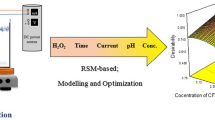Abstract
The objective of this study was to investigate the combined effect of temperature (15–35°C), pH (3-9), and dipping time (1–5 min) on the inactivation of Staphylococcus aureus in broth treated with low concentration electrolyzed water (LcEW). Reductions of 1.44–7.12 log CFU/mL were observed in different combinations of the 3 factors. Also, a quadratic equation for S. aureus inactivation kinetic was developed by multiple regression analysis using response surface methodology. The predicted values were shown to be significantly in good agreement with experimental values as a result of the level of significance was p<0.0001. Besides, the developed model was validated by fitting with literature data and the results showed that the predictions had a good agreement with the observed data with a satisfied determination of coefficient (R2=0.963).
Similar content being viewed by others
References
Seo YH, Jang JH, Moon KD. Occurrence and characterization of enterotoxigenic Staphylococcus aureus isolated from minimally processed vegetables and sprouts in Korea. Food Sci. Biotechnol. 19: 313–319 (2010)
Ding T, Shim YH, Choi NJ, Ha SD, Chung MS, Hwang IG, Oh DH. Mathematical modeling on the growth of Staphylococcus aureus in sandwich. Food Sci. Biotechnol. 19: 763–768 (2010)
Loir YL, Baron F, Gautier M. Staphylococcus aureus and food poisoning. Genet. Mol. Res. 2: 63–76 (2003)
Lee WC, Lee MJ, Kim JS, Park SY. Foodborne illness outbreaks in Korea and Japan studied retrospectively. J. Food Protect. 64: 899–902 (2001)
Huang YR, Hung YC, Hsu SY, Huang YW, Hwang DF. Application of electrolyzed water in the food industry. Food Control 19: 329–345 (2008)
Koseki M, Tanaka Y, Noguchi H, Nishikawa T. Effect of pH on the taste of alkaline electrolyzed water. J. Food Sci. 72: 298–302 (2007)
Huang YR, Hsieh HS, Lin SY, Lin SJ, Hung YC, Hwang DF. Application of electrolyzed oxidizing water on the reduction of bacterial contamination for seafood. Food Control 17: 987–993 (2006)
Issa-Zacharia A, Kamitani Y, Morita K, Iwasaki K. Sanitization potency of slightly acidic electrolyzed water against pure cultures of Escherichia coli and Staphylococcus aureus, in comparison with that of other food sanitizers. Food Control 21: 740–745 (2010)
Koide S, Takeda J, Shi J, Shono H, Atungulu GG. Disinfection efficacy of slightly acidic electrolyzed water on fresh cut cabbage. Food Control 20: 294–297 (2009)
Rahman SME, Ding T, Oh DH. Effectiveness of low concentration electrolyzed water to inactivate foodborne pathogens under different environmental conditions. Int. J. Food Microbiol. 139: 147–153 (2010)
Koseki S, Yoshida K, Kamitani Y, Isobe S, Itoh K. Effect of mild heat pre-treatment with alkaline electrolyzed water on the efficacy of acidic electrolyzed water against Escherichia coli O157:H7 and Salmonella on lettuce. Food Microbiol. 21: 559–566 (2004)
Len SV, Hung YC, Erickson MC, Kim C. Ultraviolet spectrophotometric characterizations and bacterial properties of electrolyzed oxidizing water as influenced by amperage and pH. J. Food Protect. 63: 1534–1537 (2000)
Ding T, Rahman SME, Purev U, Oh DH. Modelling of Escherichia coli O157:H7 growth at various storage temperatures on beef treated with electrolyzed oxidizing water. J. Food Eng. 97: 497–503 (2010)
Ding T, Rahman SME, Oh DH. Inhibitory effects of low concentration electrolyzed water and other sanitizers against foodborne pathogens on oyster mushroom. Food Control 22: 318–322 (2011)
Rahman SME, Ding T, Oh DH. Inactivation effect of newly developed low concentration electrolyzed water and other sanitizers against microorganisms on spinach. Food Control 21: 1383–1387 (2010)
Lee H, Song M, Hwang S. Optimizing bioconversion of deproteinated cheese whey to mycelia of Ganoderma lucidum. Process Biochem. 38: 1685–1693 (2003)
Jin SS, Jin YG, Yoon KS, Woo GJ, Hwang IG, Bahk GJ, Oh DH. Predictive modeling of the growth and survival of Listeria monocytogenes using a response surface model. Food Sci. Biotechnol. 15: 715–720 (2006)
Box G, Behnken D. Some new three level designs for the study of quantitative variables. Technometrics 2: 455–475 (1960)
Ross T. Indices for performance evaluation of predictive models in food microbiology. J. Appl. Bacteriol. 81: 501–508 (1996)
Ding T, Dong QL, Rahman SME, Oh DH. Response surface modeling of Listeria monocytogenes inactivation on lettuce treated with electrolyzed oxidizing water. J. Food Process Eng. 34: 1729–1745 (2011)
Ozer NP, Demirci A. Electrolyzed oxidizing water treatment for decontamination of raw salmon inoculated with Escherichia coli O157:H7 and Listeria monocytogenes Scott A and response surface modeling. J. Food Eng. 72: 234–241 (2006)
Armas AD, Wynne A, Sutherland JP. Validation of predictive models using independently published data. In: Abstracts: 2nd International Conference on Predictive Microbiology. February 18–22, Hobart, Tasmania, Australia (1996)
Dalgaard P. Fresh and lightly preserved seafood. pp. 110–139. In: Shelf Life Evaluation of Foods. Man CMD, Jones AA (eds). 2nd ed. Aspen Publishing Inc., Frederick, MD, USA (2000)
Ross T. Predictive Food Microbiology Models in the Meat Industry (MSRC.003). Meat and Livestock, Australia. p. 196 (1999)
Lebert I, Robles-Olvera V, Lebert A. Application of polynomial models to predict growth of mixed cultures of Pseudomonas spp. and Listeria in meat. Int. J. Food Microbiol. 61: 27–39 (2000)
Author information
Authors and Affiliations
Corresponding author
Rights and permissions
About this article
Cite this article
Wang, J., Rahman, S.M.E., Ding, T. et al. Optimization of inactivation of Staphylococcus aureus by low concentration electrolyzed water using response surface methodology. Food Sci Biotechnol 20, 1367–1371 (2011). https://doi.org/10.1007/s10068-011-0188-1
Received:
Revised:
Accepted:
Published:
Issue Date:
DOI: https://doi.org/10.1007/s10068-011-0188-1




